Food in Egypt: A Detailed Look Into Modern and Ancient Egyptian Food + the Best Dishes To Try
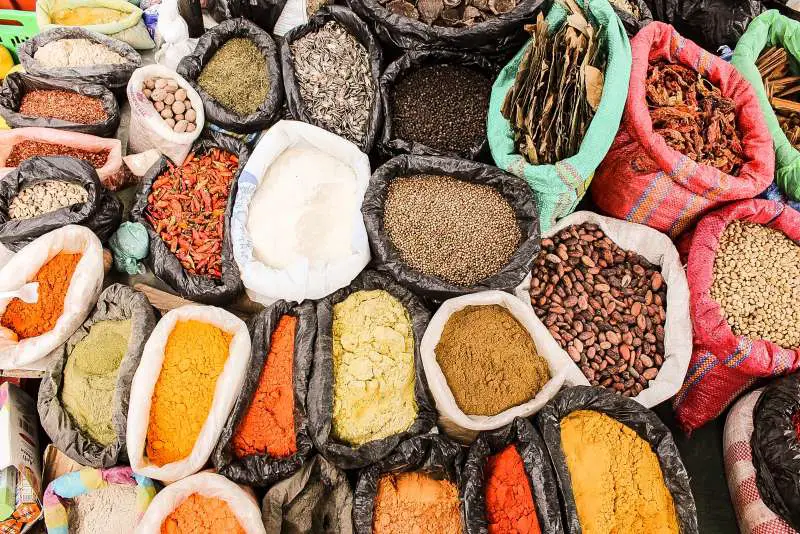
I don’t know how much you already know about food in Egypt, but what I can tell you is that there’s a whole lot more to it than shwarma and kofta. Dig a little deeper and you are bound to discover a food culture that has been influenced throughout history going all the way back to ancient Egypt. Today, I will tell you everything you need to know about Egyptian food.
If you are curious about the food of Egypt or concerned about what food to eat on your first trip here, you’ve come to the right place. Read on to discover more.
>> Planning a trip to Egypt?
MUST READ: 41 insider Egypt tips to know before you go
Remember the more adventurous you are willing to be, the more rewarding your culinary journey in Egypt will be.
Hungry? Taste buds salivating at the prospects?
Let’s go…
How about we start at the very beginning…
Food and drink of ancient Egypt
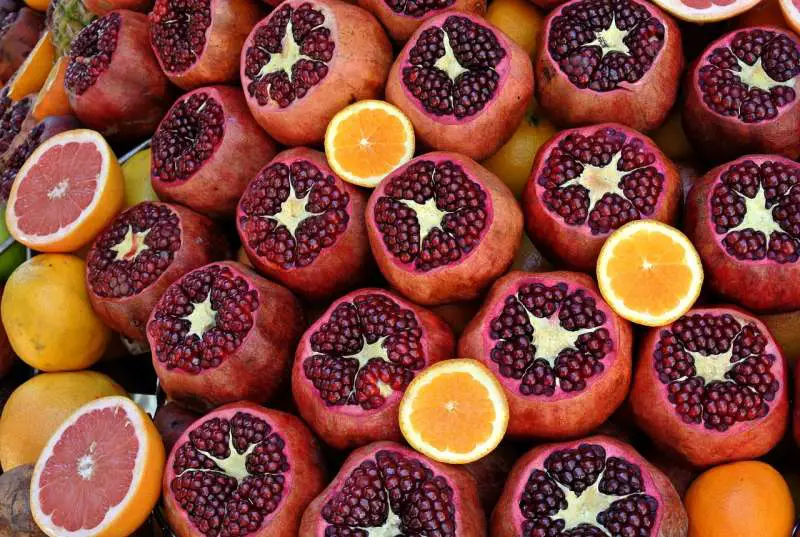
What kind of food did the ancient Egyptians eat?
Just like modern day Egypt, food was an important part of the culture in ancient Egypt.
Thanks to the Nile river, a famous landmark in Africa, there was plenty of fresh food available to sustain the region. Each year, melting snow from the mountains caused the Nile to flood. As the water receded, a rich, fertile soil was formed that was perfect conditions for growing all sorts of produce. People were also free to fish from the Nile.
Food was occasionally used as a form of payment by the ancient Egyptians.
Many of the favourite foods consumed today were also done so in ancient Egypt:
— Fiteer is said to date back to ancient Egypt when this layered bread was often used as an offering to the gods.
— Mulukhiya is a staple food in Egypt found in every kitchen that has roots in ancient Egypt, traditionally served to the Royalty and Pharaohs for its health benefits.
— Traces of ful medames have been found inside the tombs of the Pharaohs dating back to almost 2000 BC.
— Cheese is another important Egyptian food staple that goes back over 5000 years. Remnants of cheese were found in ancient alabaster jars at Saqqara and a number of Egyptian tombs, some of which date back to 3000 BC.
— While foie gras is associated with France, it was first practiced in Ancient Egypt as far back as 2,500 BC.
The staple of ancient Egyptian foods were bread and beer.
People of ancient Egypt were big fans of bread, often served as the main part of a meal.
Breads were commonly made with barley and wheat, sweetened with honey or dates. When the bread turned mouldy, it was used to fight off infections.
Speaking of honey, the history of honey dates back thousands of years with the earliest written reference thought to have been from the ancient Egyptians circa 5500 BC. It was a valuable commodity used not only for trade and religious rites, but also for medicinal use.
Did you know:
Honey, if stored well, does not go bad.
It can be stored for hundreds of years and still be edible.
Many kinds of fish from the Nile were eaten after being roasted, dried or salted. Birds such as waterfowl and pigeon were part of the menu. Pigs were eaten for a while, but was removed after the high priests made the decision that it should not be eaten.
You would think that water was the most common drink in ancient Egypt, but not so. It was beer. There were very few water wells and many Egyptians did not want to drink directly from the Nile. So a thick beer made from barley was drunk instead. This beer was very nutritious and did not have a high alcoholic component.
When they got tired of beer, white and red wine was made from the abundance of grapes. Honey and various spices were added to the wine for taste. Additionally, many non-alcoholic fruit drinks were made from the abundance of dates.
Other food items often consumed during that period were garlic, onions, lentils, vegetables, figs, dates, eggs, milk, cheese, and butter.
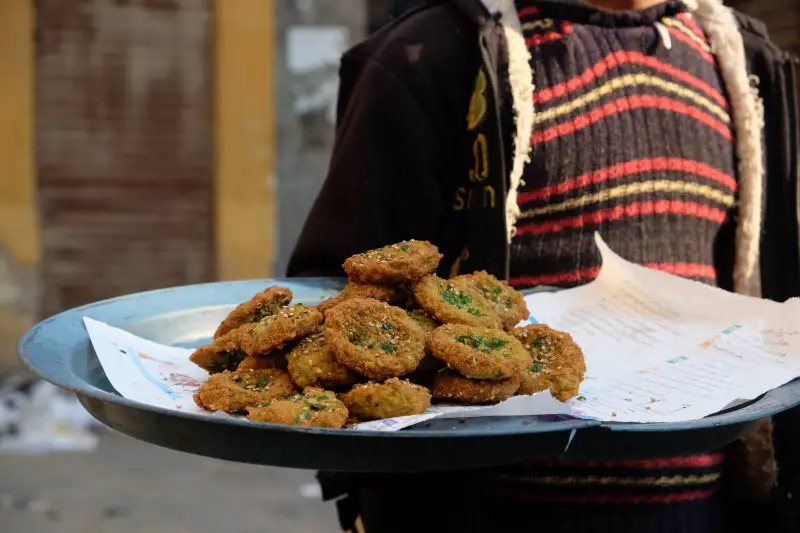
Next up is…
Food for Egypt: Understanding modern day Egyptian cuisine
Traditional food in Egypt is varied due to geography, history, and religion and has been subjected to numerous influences over the centuries. Everything from Persian, Greek, Turkish, Arabic, and other culinary influences have had a hand in shaping what we know today as Egyptian food.
More recently, the foods of other Arabic countries in the Middle East such as Lebanon, Syria, and Palestine and other North African countries have moulded the Egyptian palette.
The influences vary across the country. In Aswan you will notice the influence of Nubian culture and North Africa. In Alexandria there is a large Mediterranean influence.
An added element to Egyptian cuisine is that people in different parts of the country have a taste for somewhat differing food. These differences are particularly noticeable between the north and the south whereby in the north you will find numerous fish based dishes while spicy food is common in the south.
What type of food do they eat in Egypt
With the Nile playing a prominent role in the lives of Egyptians, the rich farming soil along its banks provides a rich bounty of fruit and vegetables. This produce is an important part of the food for Egypt.
Vegetables are also much cheaper than meat making it a popular choice and stable in many traditional Egypt food dishes. This is also due to the cost and difficulty of raising animals.
The diet is rich in vegetables, lentils, and beans.
What are the most popular foods in Egypt
Staples include Egyptian flatbread (aish baladi), koshary, ful medames (fava beans), shai (tea) and a variety of exotic spices.
Meat is still widely available, with the most popular type being pigeon, chicken, and rabbit. Lamb and beef are usually used for grilling while seafood is popular on the coast.
Because Islam is the main religion of the majority of the population, pork does not feature in traditional Egyptian cuisine. Alcohol is not given much of a high profile either.
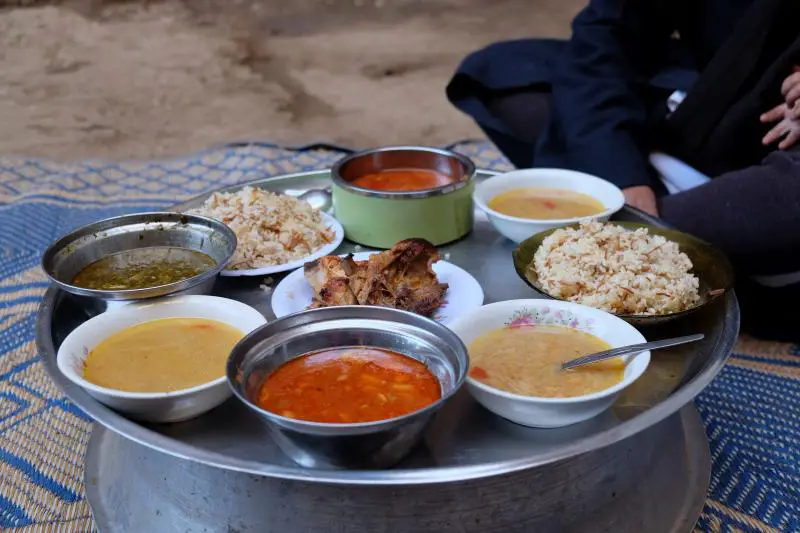
Where to find the best traditional Egyptian Food
The best Egypt food is invariably in private homes.
I was lucky enough to be invited to share many home-cooked meals while travelling in Egypt and if you are too, do not hesitate in the least.
Sharing a meal, especially in a local’s home is a wonderful way to get an inside look into the culture and life of people in another country.
On these occasions you will in all likelihood be stuffed to the point where you just cannot eat another morsel. It is a way of the host to show hospitality and appreciation to the guest of the home and the guest of the country.
The next best way to experience the best of food in Egypt is to wander the streets and gauge where the locals are eating. All social classes enjoy quick bites at street vendors and Egyptian cafes and you will discover some local hidden spots. Many serve good, cheap meals for as little to 10 LE.
Is food in Egypt safe
For the most part, yes.
You do need to take care to avoid getting stomach troubles. Many blame these health issues on the food of Egypt, but bad hygiene, too much time spent in the heat, not drinking enough water, drinking too much alcohol, and air-conditioning can all have a negative effect.
- Use an antibacterial before handling food
- Drink mineral water instead of tap water
- Lemon water is good for the system
>> Read next:
Food of Nepal: 12 traditional dishes to try
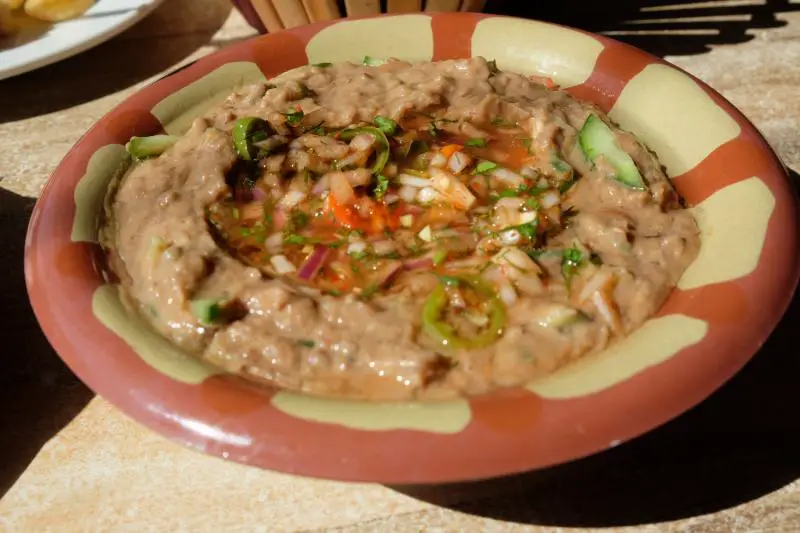
Egyptian Food Spices
Food in Egypt gets its flavour from the heavy use of spices found in kitchens all over the country. Spices such as cumin, bay leaves, cinnamon, coriander, chilli are some of the most common used to create the cuisine’s distinctive taste.
Visiting a souk is almost mandatory during your travels in Egypt and here you will be able to find all of these spices to recreate many of these dishes back home.
Now for some things to consider…
Mealtime customs: Dos and Don’ts of eating in Egypt
Before dinner, drinks are frequently served. This is a time for socializing, chatting and catching up on life in general. Mezze is served alongside as starters to share before the main meal.
When dinner is ready, usually between 9 pm and 10 pm, guests seat themselves and food is placed in the middle of the table. Bread will almost always accompany meals, which may include vegetables, soups, rice and meat dishes.
Following dinner, guests usually move into another room to enjoy tea or coffee and Egyptian desserts and sweets.
There are some general guidelines to note and follow about food and eating in Egypt:
- Shoes should always be removed before entering a house and sitting down to eat.
- The left hand is considered unclean and should not be used for eating.
- Feet should always been tucked under the table.
- Alcohol and pork should not be requested.
- When sitting down to eat, always sit next to a person of the same sex unless requested otherwise.
- Compliment the cook when appreciated.
- Refrain from eating, drinking or smoking in public during the daytime in the holy month of Ramadan.
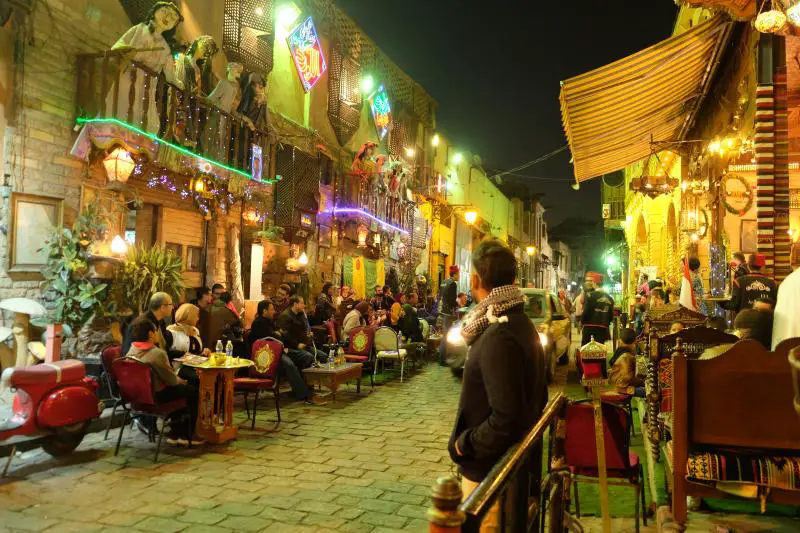
Let’s break it down even further
Street (Fast) Food Egypt
A big part of food for Egypt is the street food culture.
Everywhere you go the smell of local delights beckon before the sight invites to try some. Street food in Egypt is readily available and at a very good price.
Be sure to try some, if not all, of the following:
Ful medames – spicy slow cooked mashed fava beans popular for breakfast.
Koshari – Egypt’s favourite fast food. Traditional vegetarian dish of rice, macaroni, lentils, chickpeas, sauce, and spices.
Shawarma – marinated meat slowly cooked on a rotating spit.
Ta’ameya – a popular street food found everywhere made from fried crushed fava beans.
Fiteer – stuffed stone-fired bread resembling a pizza. Savoury or sweet.
Hawawshi – Egyptian meat pie.
Simit – a sesame covered bread resembling a pretzel.
Aish Baladi – a flat bread made of whole wheat, bran, water, and salt baked in a wood burning oven.
Vegetarian Food in Egypt
Is Egypt suitable for vegetarians/vegans?
Vegetarians and vegans will be happy to know that Egypt is a friendly place for plant-based diets. There are not a lot of cafes that would be described as vegan, but you will easily find many delicious meals prepared from vegetables, legumes, and well-flavoured with local spices.
This list includes (but not limited to):
Mezze – small dishes of salad and dips served to share before a main meal.
Koshary – Egypt’s favourite fast food. Traditional vegetarian dish of rice, macaroni, lentils, chickpeas, sauce, and spices.
Ful Medames – spicy slow cooked mashed fava beans popular for breakfast.
Ta’ameya – a popular Egyptian street food found everywhere made from fried crushed java beans.
Baba ganoush – grilled aubergine with tahini.
Mulukhiya – a thick green soup made from jute leaves.
Mahshi – stuffed vine leaves with vegetables.
Bayma – okra soup.
One thing to note is the slight possibility of vegetarian dishes flavoured with meat stock. Your waiter may not even consider such stock to be meat, so they will reassure you that the dish is vegetarian. It helps to double-check in this regard.
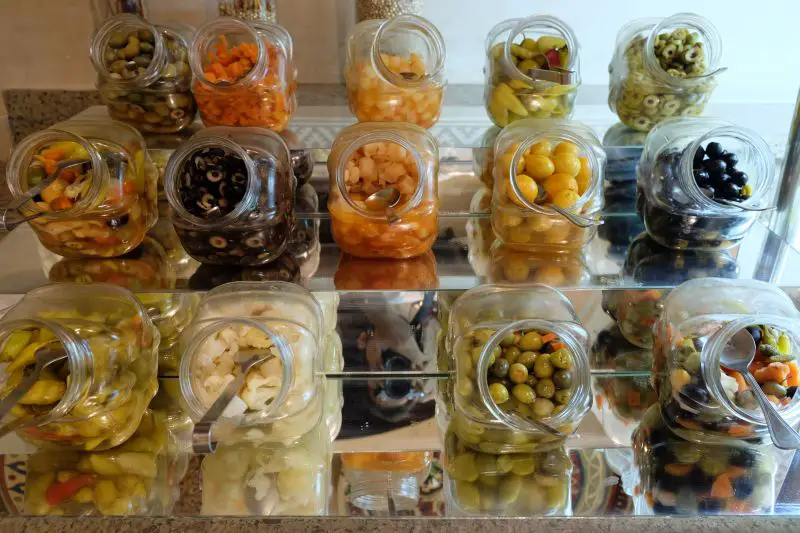
Meat Dishes of Egypt Food
There are also plenty of Egyptian dishes that incorporate meat, from religious celebratory meals to simple grilled fare. Keep an eye out for these popular options:
Fattah – a celebratory meal of rice, lamb, and fried baladi.
Shawarma – marinated meat slowly cooked on a rotating spit.
Hawawshi – Egyptian meat pie.
Kamounia – beef and liver stew.
Kofta – grilled meat most often veal.
Sheesh Kebab – grilled minced meat.
Hamman mahshi – stuffed pigeon that is a delicacy food for Egypt.
Egyptian Desserts and Sweets
Desserts play a huge role in the food culture in Egypt. Sweet sweet goodness. Do I even need to say any more?
Baklava – layers of flaky filo soaked in honey and nuts.
Basbousa – a sweet semolina cake.
Konafah – traditional Egyptian dessert made from shredded semolina flour noodles.
Fiteer – sweet stuffed stone-fired bread resembling a pizza.
Halawa – a sesame paste sweet confection.
Bouzat Haleeb – Egyptian ice-cream.
Umm Ali – baked layers of bread soaked in milk.
Kishk – a cold yogurt sauce.
Roz Be Laban – vanilla-flavoured rice pudding.
>> Read next:
Where to find the best gelato in Rome
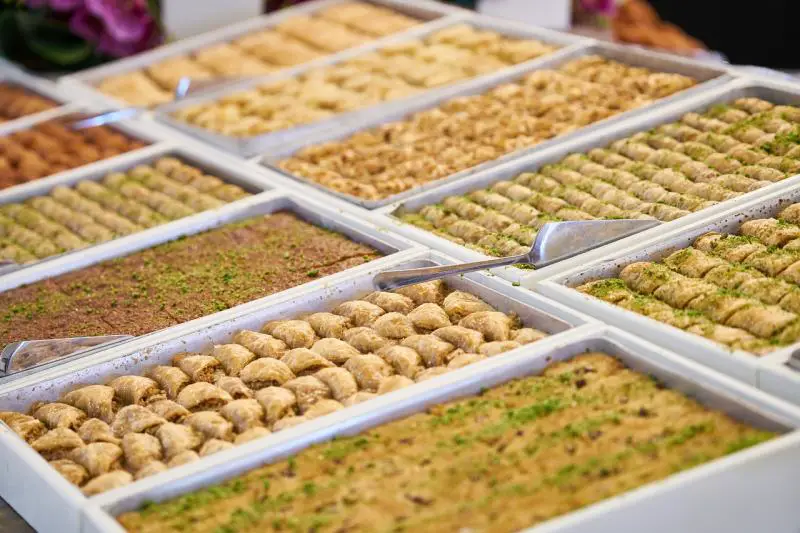
Egyptian Mezze Food
Mezze style meals are common all around Egypt, with lots of little dishes served with bread in the centre of the table to share before a main meal. Egyptian food dips are plentiful and vegetarian friendly.
Take time to try a handful of these delicious food options when in Egypt:
Baba ganoush – grilled aubergine and tahini dip.
Bessara – a cold fava bean purée.
Hummus – a mashed chickpea dip blended with lemon, garlic, and sesame paste.
Tahini – a ground sesame seed paste with oil, garlic, and lemon.
Wara ainab – vine leaves stuffed with rice, meat, and herbs, cooked in a broth.
Kibbeh – bulgur wheat stuffed with minced lamb and pine nuts.
Sambusas – mini pies filled with either cheese or meat.
Torshi – crunchy pickled vegetables – cucumbers, carrots, and turnips.
Duqqa – a dip made from the fine mix of ground nuts, herbs, and spices.
Tabouli – fresh parsley, wheat, lemon, mint, and onion mixed together.
Seafood from Egypt
When travelling along the coast of Egypt and spending time in any of the cities on the Mediterranean or Red Sea, you will come across a variety of seafood dishes. This is particularly prominent in Dahab, Alexandria, Sinai, Sharm el-Sheikh, and other cities along the Red Sea coast where you will notice plenty of seafood options that you won’t find inland.
It is generally fresh having ready access to the nearby waters. Common fish like Nile perch, snapper, sea bass, and squid can be found on sale fresh out of an icebox to be grilled or fried for a hearty meal.
The most common seafood dishes in Egypt include:
Sayadeya – fillet of white fish baked in a tagine-like pot.
Fesikh – a traditional dish made from dried, salted, and fermented saltwater fish.
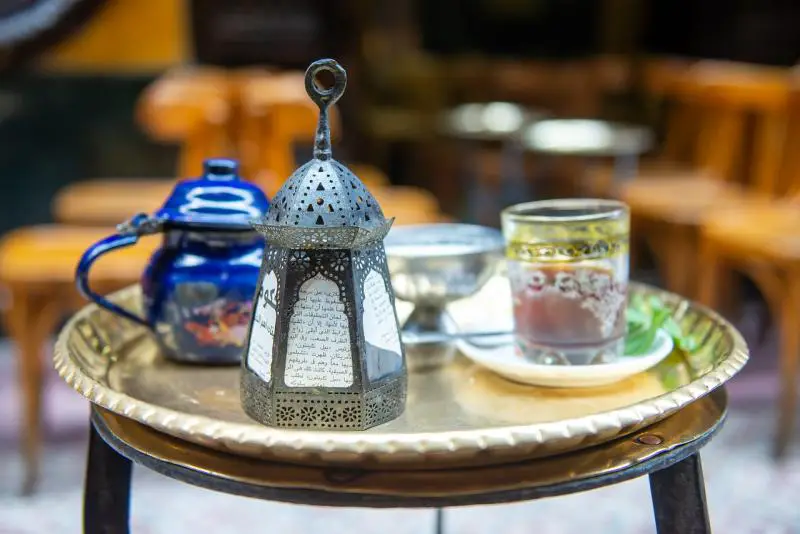
Drinks in Egypt
No list of foods from Egypt is complete without a mention of the drinks.
Let’s talk about Egyptian Tea culture because it is such a prominent aspect of the nation.
Tea is the national drink in Egypt enjoyed throughout the day both during and between meals. Cafes are filled with locals who gather to share shai, converse, listen to music, and to play backgammon or dominoes. It is customary to offer tea to guests, both at home and at local shops.
There are two main types of tea in Egypt:
- Koshary tea
Black tea flavoured with mint leaves and sweetened with cane sugar - Saiidi tea
A heavy tea steeped for over 5 minutes and heavily sweetened with sugar.
Koshary tea tends to be more popular in northern Egypt while Saiidi tea is preferred in the south of the country.
Herbal teas are also popular, especially refreshing hibiscus tea.
Coffee is served “saada” meaning bitter or “ziyada” for very sweet.
As a predominantly Muslim country, alcohol is given a low profile in Egypt. Public drunkenness is unacceptable, and sale of alcohol is prohibited during the holy month of Ramadan or on the Prophet Mohammed’s birthday with a few exceptions.
Whether you’re sipping koshary tea over breakfast or enjoying a cold hibiscus tea on a hot day, integrate Egypt’s tea-drinking culture into your visit as much as the food.
A couple of the most common local drinks are:
Shai – tea in Egypt
Asiir – fruit juice
‘Ahwa – coffee in Egypt
Karkaday – a traditional drink made from red hibiscus flowers
Sahleb – a thick, creamy drink made from wheat, milk, and nuts
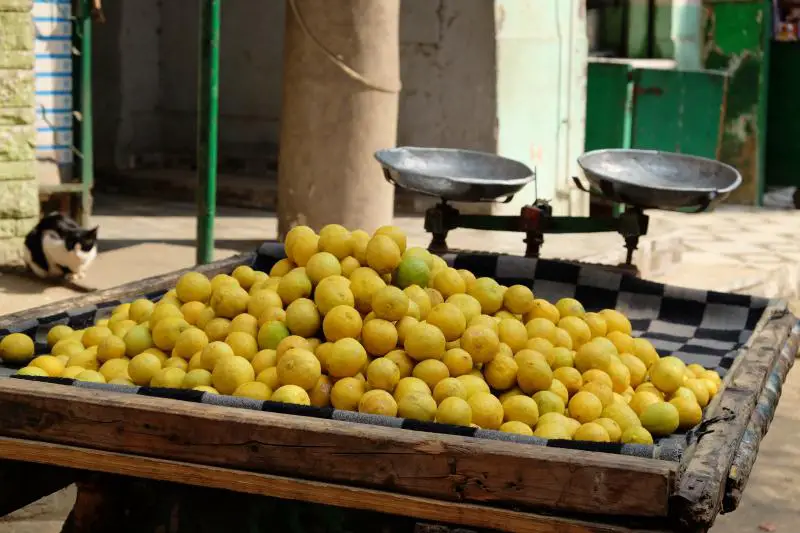
Famous Typical Traditional Food in Egypt you must try
Now that you’ve got a good overview…
… Let’s discuss a couple of the most popular and traditional food dishes to look out for when travelling in Egypt.
What can you eat and drink in Egypt
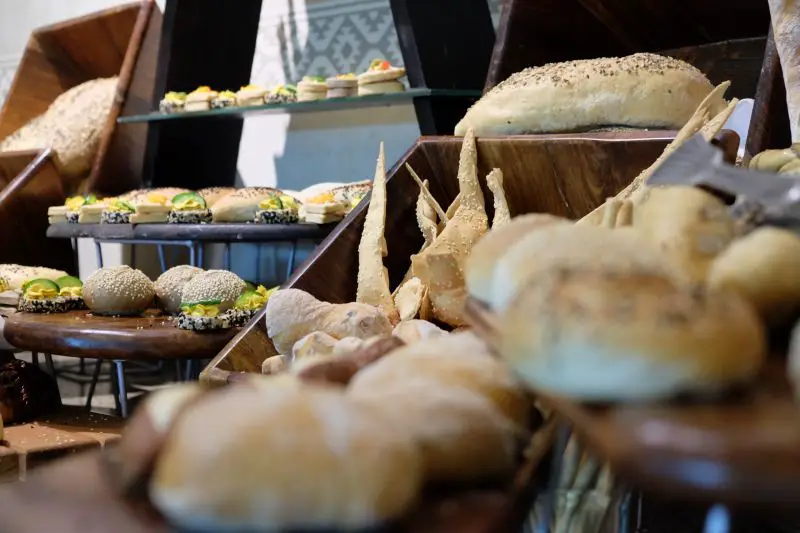
Koshary (Also known as Kushari)
*street food *vegetarian *vegan (if vegetable oil is used)
If ever there was a national food for Egypt, Koshary would be it.
This traditional vegetarian dish consists of food items you would never think would go good together. However, somehow they do. Comprising rice, spaghetti, macaroni, black lentils, Baharat spice blend, and garnished with a chilli tomato sauce, garlic vinegar, chickpeas and crispy fried onions.
Strange combination, right? Carbs on carbs making carbs that provide a good mix of flavour and texture. Don’t simply take my word for it. Make a mental note and be sure to try this food from Egypt.
Koshari is said to have originated from a rice and lentil Indian dish that the British settlers brought to Egypt in the late 19th century. Pasta was added to the dish by the Italians living in Egypt. The locals then added their own touch to the dish by adding legumes, tomato sauce and fried onions.
This unusual but humble dish is Egypt’s favourite fast food. You will come across Koshary almost everywhere, without having to go out and look for it. This cheap, homely meal is a staple dish of every household in Egypt. It is commonly sold at street-food vendors and can also be found in many restaurants to be enjoyed any time of the day.
Shawarma
With roots in the Ottoman Empire, this popular Middle Eastern food made its way into Egypt during the time when the region was under the control of the Ottomans.
Similar to Doner Kebab in Turkey and Souvlaki in Greece, Shawarma comprises marinated meat that is slowly cooked on a rotating spit. You will see these meat machines on nearly every corner that make for popular street food in Egypt. The outer layer of the meat is shaved off the spit and often served in pita bread along with toppings the likes of chopped tomatoes, onion, lettuce, pickled vegetables, and tahini or hummus sauce.
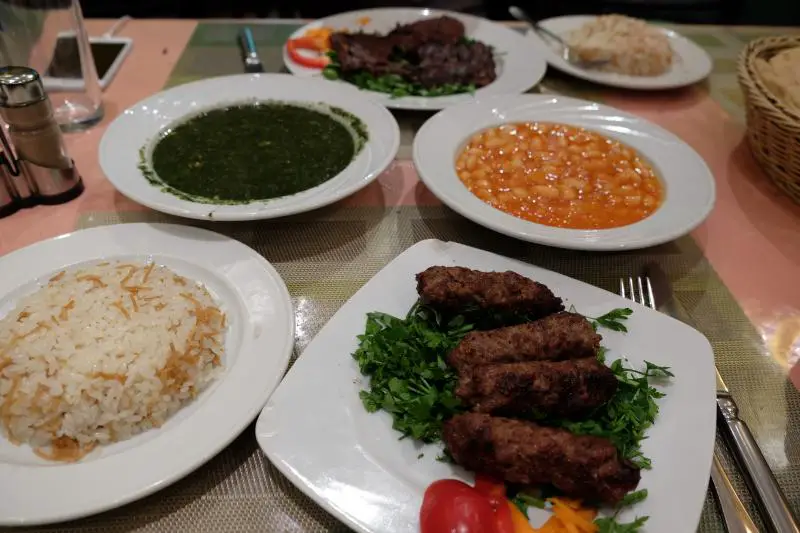
Kofta and Sheesh Kebab — Grilled meat
Usually prepared with grilled veal lamb, or minced meat, Kofta and Kebab are classic Egyptian food found in most restaurants. After being grilled over charcoal, it is traditionally accompanied with baladi (bread), salad, and tahini, baba ghanoush or a tzatziki dip.
Did you know:
When ordering a mixed plate in Egypt, this comes served as an equal mix of Kebab and Kofta.
Basbousa
A sweet cake made primarily from Semolina and drenched in syrup, Basbousa is a popular sweet dessert post dinner in Egypt.
The syrup is made from rose water, honey and lemon. The cake is traditionally topped with coconut and almonds and is easily distinguished by its diamond square shape.
Fiteer Baladi
Egypt’s version of pizza, Fiteer is a stone-fired bread made with thin layers of filo pastry and butter. It is then stuffed with an array of ingredients and can be found in both the sweet or savoury variety.
Common savoury ingredients include meat, cheese, olives, peppers, and tomato while the sweet variety often comprises syrup, raisins, honey, sugar or cream.
Fiteer is said to date back to ancient Egypt when this layered bread was often used as an offering to the gods.
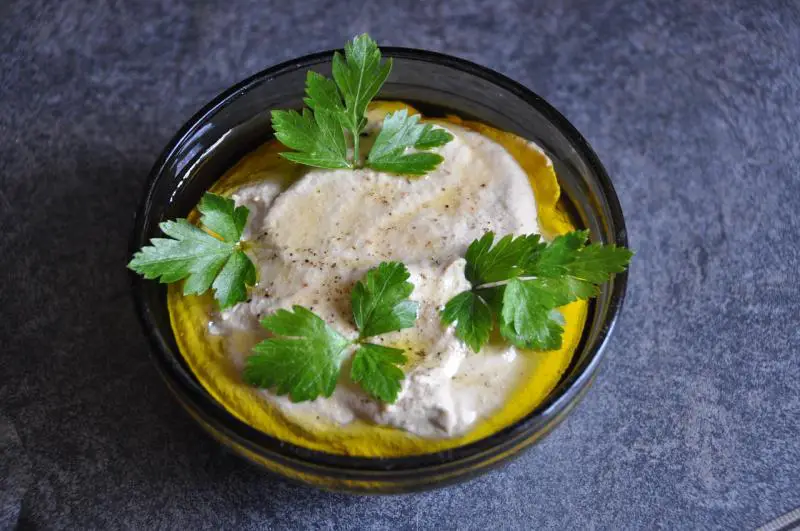
Baba Ghanoush
My favourite Egyptian dish is this ↑
Grilled eggplant that is peeled, mashed, and mixed with tahini, lemon juice and other spices makes baba ghanoush delicious on its own or often as an accompaniment to a sandwich or pita bread. This is a must try food in Egypt and the creamy, smoky flavour will have you asking for seconds.
Hawawshi
Think meat pie, Egyptian style.
Spiced ground beef and onions are mixed in a whole loaf of aish baladi bread before being baked in traditional wood oven. The best kind are baked so well you would think it was deep-fried.
Hawawshi is a popular Egypt street food option. It is also commonly made in homes incorporating onions, tomato, peppers, and an assortment of spices.
Mulukhiya
Made from the leaves of jute (mallow) plants that grow in North Africa, Mulukhiya is prepared by finely chopping the leaves with the addition of a good dose of garlic, coriander, and lemon juice. It is then boiled in animal stock until thick and served alongside rice or bread.
It is a staple food for Egypt that can be found in every Egyptian kitchen. With roots in ancient Egypt, Molokhiya was traditionally served to the royalty and Pharaohs for its health benefits. If you can get pass the slimy texture you will find a rich, aromatic flavour and reap a whole lot of health benefits too.
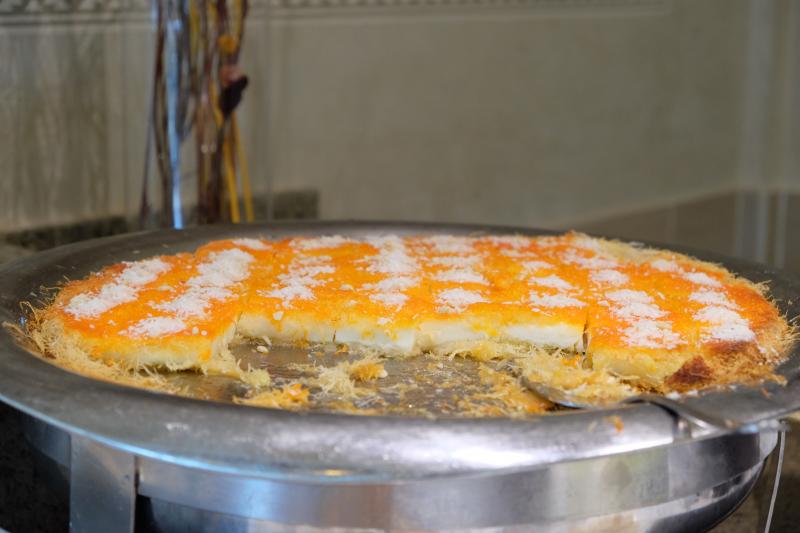
Konafah
A traditional Middle Eastern and Egyptian dessert made from shredded semolina flour noodles, konafah is filled with cream or ricotta cheese as the middle layer and baked to a deliciously rich treat in a deep tray. Once it’s taken out of the oven, it is soaked in a sweet syrup to be served hot or cold.
The noodles are sometimes replaced with filo pastry or shredded wheat, while the fillings vary from nuts to whipped cream, honey or custard.
It is a must try dessert in Egypt that is sure to satisfy any sweet tooth and is most popular in gatherings during Ramadaan.
Hamam Mahshi
Somewhat of a delicacy in Egypt, Hamam Mahshi is stuffed pigeon.
Yeah, you read that right — stuffed PIGEON.
This popular dish often served on special occasions is made from pigeons raised in specially made mud brick conical towers until they are 6 weeks old. The young birds are then marinated and stuffed with a mix of freekeh (cracked green wheat) or bulgur wheat, nuts, onions, and spices before being grilled over a wood charcoal fire until golden brown.
It can be difficult to eat because of all the tiny bones, but that doesn’t stop the locals who claim this Egypt food dish as one of the country’s finest.
Fattah
A celebratory Egypt food, often eaten on special feasts and religious festivals such as Eid-ul-Adha, Fattah is made up of layers of rice, lamb, and fried pieces of baladi bread mixed with a garlic vinegar dipping sauce. This is then seasoned with a spiced tomato sauce.
You should be able to find Fattah outside of religious festival dates. This traditional Nubian dish is best eaten homemade, but you can also find it in most traditional restaurants all over Egypt.
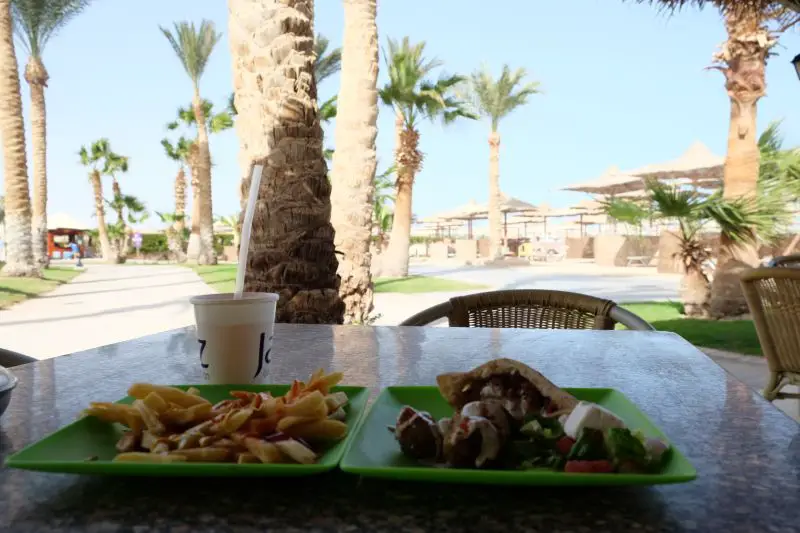
Umm Ali
Let’s talk more Egyptian desserts. Layers of bread or puff pastry soaked in milk, cinnamon, and sugar topped with raisins, nuts, and coconut and makes Umm Ali Egypt’s very own version of bread pudding.
Once baked in the oven it is served hot and is always a crowd pleaser. The literal translation for this dessert is Ali’s mother. Legend has it that Sultan Aybak’s wife made this dessert for the people of the land as a victory celebration. It has since been named after her.
Baklava
If I could only eat one dessert for the rest of my life Baklava would be it.
Layers of flaky filo pastry soaked in honey and filled with crushed nuts topped with a sweet syrup. You will spot this tasty treat almost everywhere in Egypt from cafes to restaurants. Resistance is often futile.
Egyptian Mahshi
This popular food dish, prevalent in all Mediterranean countries, is a firm favourite among Egyptians.
Stuffed vegetables the likes of peppers, aubergine, and courgettes with rice and seasoned with herbs and spices makes Mahshi a hearty vegetarian food in Egypt.
Ta’ameya
Falafel needs no introduction having made its way across the world. However, in Egypt food — instead of chickpeas fava (broad) beans are used instead.
The beans are crushed into a paste, mixed with chopped onions and spices, rolled into a ball and fried. The extra crunchy texture comes from being coated in sesame seeds before being fried. Usually served with tahini sauce, salad, and aish baladi, Ta’ameya is vegan, cheap, and delicious. It is a popular street food option enjoyed at breakfast or lunch and can be found everywhere.
Ta’ameya has been a staple for over 1000 years and remains the original Egyptian fast food.
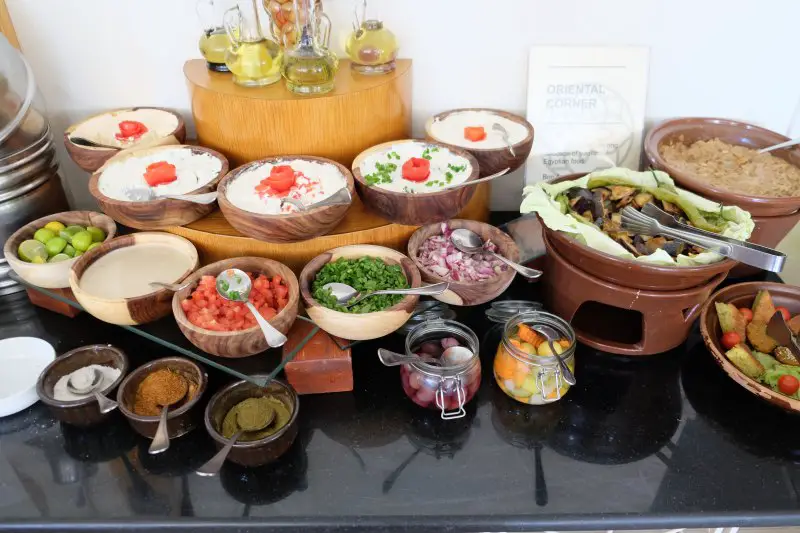
What do Egyptians eat for breakfast?
Ful medames
Beans for breakfast? I have my doubts, but it sure is a hit in Egypt.
Ful is a national food favourite and widely available.
Slow cooked mashed fava beans makes for a spicy stew seasoned with salt, garlic, pepper, cumin, parsley, and olive oil. The beans are simmered overnight in a massive round cauldron-looking pot called a Qedra. The dish is common across Africa and the Middle East. Traditionally eaten at breakfast, it is usually served with aish baladi and pickled vegetables.
Along with ta’ameya, ful medames remain the original fast food in Egypt and a national dish thought to date back to the time of the pharaohs of ancient Egypt. Traces of ful medames have been found inside the tombs of Pharaohs dating back to almost 2000 BCE.
It remains one of the most favourite foods in Egypt today and you will find it at one of the many ful carts along the streets, or in numerous restaurants served as a traditional mezze.
Halawa
A popular dessert in Egypt made from sesame paste, Halawa is a common staple food among Egyptians, often eaten as a snack.
Available in all shapes and forms, Halawa is one of the few food items that is able to tolerate the Egyptian heat without needing any special storage conditions and without going bad.
Bamya
Prepared using the green seed pods of the okra plant to make a soup, Bayma is hugely popular all around Egypt. Mixed with cubes of meat, tomatoes, onions, and many spices, the dish has evolved throughout the region of North Africa and the Middle East. It is a quick and easy meal that is also healthy and filling.
Simit
A classic baked good that has its origins in Turkey, Simit is a sesame-covered bread that resembles a pretzel or a bagel. It is usually served with a hard-boiled egg and this Egypt food is most popular around Easter time during the celebrations of Sham el-Nessim.
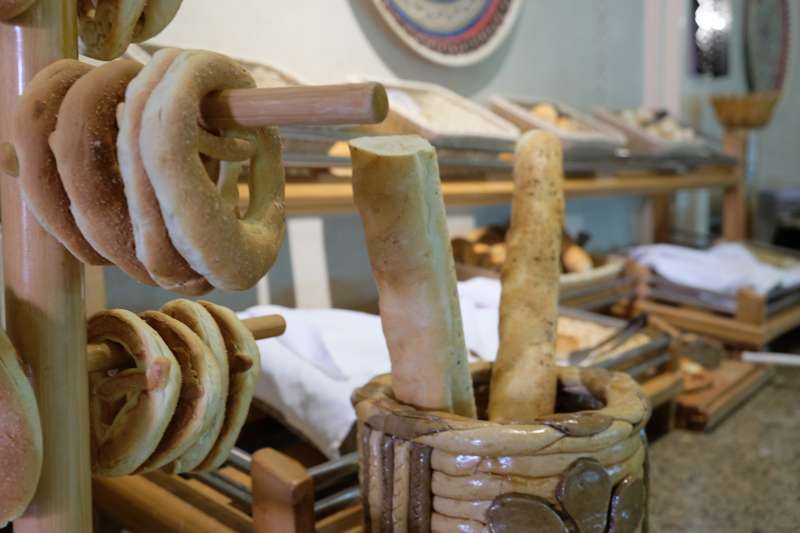
Bread
Egyptian cuisine (and life) wouldn’t be the same without its bread! During your trip to Egypt, you’ll find plenty of pita bread to wrap all your falafel and kebabs and dip into flavorful sauces.
Keep an eye out for:
Aish Baladi
Aish, the Egyptian word for bread, also translates to life.
Aish bread is the single main Egypt food item that locals cannot do without. I noticed this everywhere and it’s an important part of every meal. This flat bread is made of whole wheat, bran, water, and salt – traditionally baked in a wood burning oven.
It can certainly be eaten whole on its own, especially immediately after being made and still hot. Traditional Egyptian bread is a thick pita and is often used to wrap kebabs and falafel or as a utensil to scoop up food and sauces.
Aish shamsi – a sourdough bread popular in Upper Egypt.
Aish fino – an elongated bread roll (similar to a baguette) that is often used to make sandwiches.
Cheese
Cheese, another staple food of Egypt thought to have originated in the Middle East region, is an important part of traditional cuisine.
You’ll find cheese featured in a lot of Egyptian dishes, from breakfast to street food and as a component in a handful of the main food dishes and dessert too.
A couple of the local favorites include:
Domiati cheese — a popular soft, white, salty cheese made from cow or buffalo milk. The most common cheese in Egypt.
Mish cheese — a salty fermented homemade cheese common in the rural areas of Egypt.
Areesh cheese — a soft white cheese made from curdled milk, known locally as laban rayeb.
Liver Sandwiches
Liver is a common ingredient in many food dishes in Egypt. Particularly in Alexandria where liver sandwiches are a speciality found in fast food shops and street vendors.
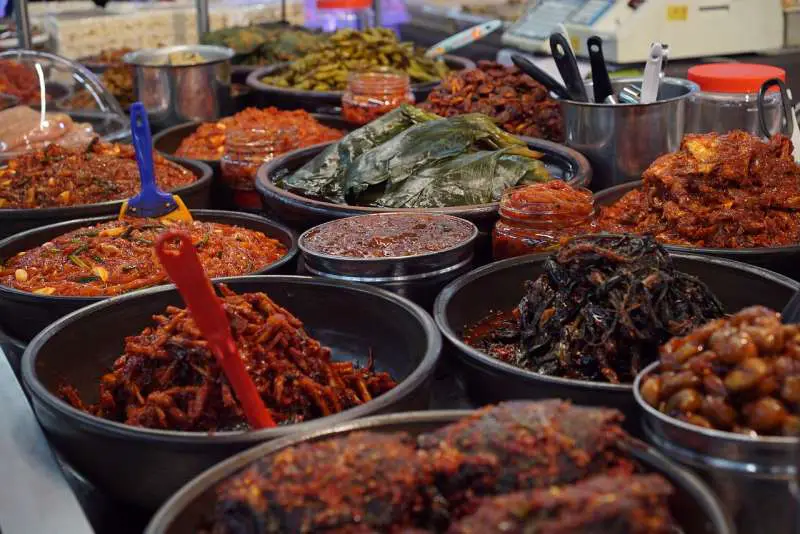
Fesikh
This traditional Egyptian food dish made from dried, salted, and fermented saltwater fish from the Mediterranean is a popular choice during the springtime festival of Sham el-Nessim.
Sayadeya
A coastal Egyptian food delicacy cooked with rice and an onion tomato sauce, sayadeya is one for the seafood lover.
Fillets of white fish are marinated in a lemon juice and baked in a tagine-like dish resulting in a fragrant fish that is soft to the touch. The kind of fish often used in the dish include traditional bass, mullet, or bluefish. Seafood is common in the coastal cities of Egypt such as Alexandria, Port Said, or Suez.
Fruit
Despite the country’s dry climate and a shortage of arable land, Egypt grows a variety of fresh fruits.
Pomegranates are common and are a must-try food in Egypt.
Other fruits commonly grown that you will find include Mohz (bananas), burtu’aan (oranges), battiikh (melon), khukh (peaches), anub (grapes), and berkuk (plums).
Prickly pear is also available for a short season between August and September. This fruit makes for a refreshing treat on a hot summers day in Egypt.
Dates are native to the region and are available everywhere. The quality is amazing and the price is even better. Buy yourself a few kilos and enjoy.
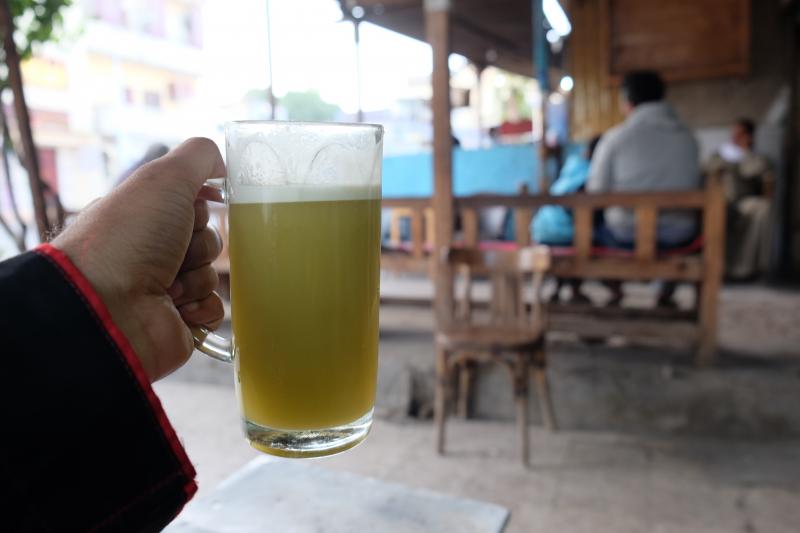
Aasir Fruit juice
Vendors all around Egypt also sell a variety of freshly squeezed juices, or asiir, with my favourite being sugarcane juice.
These make for a wonderful refreshment at any time of the day and I urge you to try as many as you can. You will find that every main street has a handful of juice stalls offering many of these inviting drinks in Egypt.
Common fruits used in the making are guava, strawberry, mango, pomegranate, banana, and even hibiscus flowers.
Assab sugar cane juice
Egyptians love assab for its sweet taste and for its health benefits. And so do I.
This drink made from sugar cane can be found at almost any juice shop. I found it hard to pass by of these and not get a dose of this delicious drink in Egypt.
Pomegranate juice
A heavenly blend of fresh Egyptian pomegranate juice.
Karkaday
A traditional Egypt drink made from red hibiscus flowers, Karkadeh is made by boiling the dried leaves of the flower. The water is then chilled and sugar added. Most popular in Luxor and Aswan, it is an equally refreshing drink enjoyed both hot or cold.
Sahleb
A thick, creamy Egyptian food drink made from milk, Sahleb is the go-to drink on a cold winter’s evening. Thickened with ground orchid root, cinnamon and nuts it goes down well to warm your insides. Cheers!
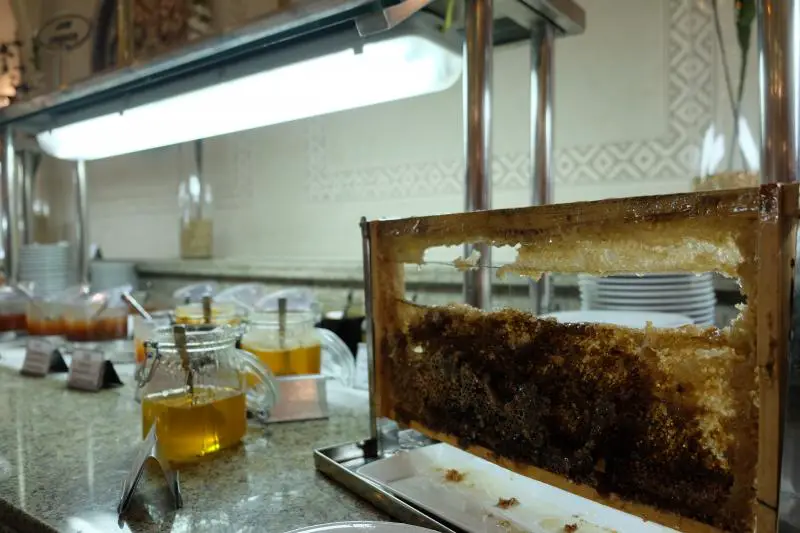
I’m willing to bet you’re pretty hungry right about now?
If you are, do make sure to check out this list of the 35 weirdest-strangest-grossest food consumed around the world. That is sure to put any hunger pangs at bay!
No? What about learning more about the food in Finland or the best Nepalese dishes to try.
I hope you’ve enjoyed learning more about the food from Egypt and the best dishes to try.
Please take a moment to share with all the foodie travellers you know and be sure to check out these important travel tips for Egypt. After all, it is one of the best countries to visit in Africa.
Bon appétit,
Rai




 New Here?
New Here? 













My aunt has been thinking about trying some different foods and world cuisine that could be really different. Getting some Egyptian cuisine from a professional could be really useful for her. I liked what you said about how honey was often used in medicine as well as religious rites
Glad you like! Thanks for reading
Yum… Now I have to go to egypt for the food
You are not going to regret that decision 😛